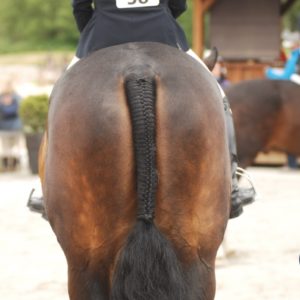Last week, we reviewed the basics our youngsters need to know before learning to move in a long rounded frame.
“Frame” refers to the position of the horse within an imaginary rectangle, with his nose at one end and his tail at the other. Generally, we start with a long frame, which is easier for the horse to achieve. In some disciplines, we stay there. In others, like dressage, we usually move to a shorter frame over time, so that the horse is packaged into a shorter imaginary rectangle.
Hindquarter engagement, neck position, and headset vary across disciplines and with time. So, today’s dressage horses often work with their heads high, necks arched strongly upward from the withers, but noses tucked in to create vertical faces.
Show hunters more commonly work with long necks for balance over fences, mid-level head height, and vertical faces. Occasionally, hunter headsets change in fashion to slightly ahead of vertical, more like a cross-country or field hunter would use.
Cutting horses are encouraged to carry their heads very low, with necks extended, but hindquarters strongly engaged and tucked under the belly. Western pleasure horses in the 2020s work in an extremely downhill position (withers below croup) with their lower hind legs behind their hips and their heads very low.
And so on, for each discipline and the competitive fashion of each time.
Conformation and breed also determine roundness and frame. Try as she might, a long lean racing Thoroughbred is going to be hard put to squeeze herself into a short dressage frame. A horse with a short neck will have trouble extending it for balance, and an uphill breed is not ideal for Western pleasure.
I’m not saying it can’t be done, just that it’s more of a challenge for both horse and rider.
Conformation and behavioral challenges also affect the sequence of roundness training. For example, my green Dutch Warmblood True has a nice but not overly long neck. Regular readers of this column know he is also not super keen on moving forward off my leg, though he’s better now than before.
Because of his conformation and forward reluctance, I purposely do not ask him to bring his face to vertical at the beginning of roundness training. Doing so causes most horses to shorten their necks, slow down, and get behind the leg. (Could we just use more leg? Sure! But we’re working with babies here, remember? More leg while also setting the head is likely to confuse a young or green horse who has only just learned single aids.)
Instead, I teach True first to extend his neck and lower his head. In a few months, when he’s got that down pat while still moving strongly forward, I’ll add the nose tuck to get his face vertical. I would probably change this sequence on a horse with a long neck and more go than whoa.
It takes about a year of practice for a young horse to develop the physical musculature and mental stability needed to round her back consistently during movement. Doing too much too fast encourages horses to shorten their necks, brace their mouths, get physically sore, and/or become psychologically frustrated. Frustration can result in nasty evasions, like bucking, kicking, grabbing the bit, bolting, or rearing—all that stuff we don’t want!
Next time, I’ll hop on True and describe exactly how to begin teaching the basics of roundness.
Related reading:
Brain-Based Horsemanship is a weekly column that chronicles Janet Jones, PhD, and her journey with True, a Dutch Warmblood she trained from age three using neuroscience best practices. Read more about brain-based training in Jones’ award winning book Horse Brain, Human Brain.

A version of this story originally appeared on janet-jones.com. It is reprinted here with permission.




 August 31, 2023
August 31, 2023 






















